Welcoming diners such as Twitter CEO Jack Dorsey, sporting icon David Beckham and superstar musician Ed Sheeran would be enough to make any restaurateur weep with joy.
But for Hisato Hamada, the 42-year-old co-founder of Tokyo’s white-hot Wagyumafia restaurant brand, which serves the world’s finest cuts of Kobe beef, it’s all in a day’s work. Well, around a month’s, to be precise.
The three headline-makers all visited Wagyumafia’s The Butcher’s Kitchen restaurant in the span of just a few weeks, all happily posing alongside Hamada – and his trademark $185 Chateaubriand steak sandwich.
In fact, Beckham is such a fan that whenever he’s in Hong Kong or Tokyo, he visits one of the Wagyumafia restaurants. He even flew Hamada to Indonesia to cook at a private family party.
They’re not alone. Movie director Guy Ritchie and Russian DJ Zedd have also happily tucked in.
During the recent Rugby World Cup, giants of the game jostled to get one of the restaurants’ coveted nightly seats.

A raucous evening – if you can get in
Wagyumafia currently has five restaurants. These include a special outlet for their $180 “sando” Chateaubriand sandwich, a new spot for yakiniku where you cook your own beef on a grill, and their flagship space in swanky Akasaka.
They also have one outpost in Hong Kong and another soon to launch in Manila – with more to come.
Wagyumafia’s success can be owed to a mix of often raucous Japanese restaurant hospitality, some of the world’s most exclusive and expensive cuts of beef – and very smart marketing.
Reservations in Wagyumafia’s five compact restaurants are very hard to come by, not least because three of them are open for members only (memberships can be purchased online when reserving at table, currently for 15,000 yen.)
When you get there, don’t expect a romantic meal for two.
Blaring soundtracks of everything from soul and hip-hop to rock anthems and cheesy pop classics make for a full-on environment where you invariably end up singing along.
Copious optional amounts of alcohol, be it champagne, beer, sake or highball cocktails, help to ensure that proceedings often carry on much later than you’d expect.
Hamada himself is much of the draw, a gregarious host who makes an evening fly by, explaining the dishes and story behind the stellar Kobe beef.
The Kobe beef back story
All of this begs the question: Is the beef really that good?
The Kobe beef served at Wagyumafia certainly has a storied history.
The word “wagyu,” seen frequently on global menus, translates simply as “Japanese cattle.” This broad umbrella term encompasses four official breeds: the Japanese black, the Japanese brown, the Japanese poll and the Japanese shorthorn.
The Japanese black is the most common and has three bloodlines but, among them, Tajima cattle have historically been isolated deep in the mountains, meaning they avoided cross-breeding with foreign animals.

As a result, only pure-blood Tajima cattle bred, raised and slaughtered in Japan’s Hyogo prefecture can today be called Kobe beef. Only 4,500 or so cattle are certified every year, the vast majority of which are served to the domestic Japanese market, including Wagyumafia.
Scarce space for grazing is another issue in Japan, which, along with a lack of stress, helps the cattle to develop its famed marbled fat.
Generally, the more marbling the better, as it makes the meat both tender and flavorful. The highest-grade USDA beef features around 6-8% of marbled fat, but in the highest quality Kobe beef served at Wagyumafia and elsewhere, it can reach a whopping 25%.
If that sounds difficult to digest, it’s worth noting that cuts of Kobe beef are generally much smaller than their US counterparts, while their fat is also largely monounsaturated.
Tastewise, people often remark on the sweetness of the meat, with vanilla one of the flavor profiles most frequently mentioned. As for texture – well, you barely need a knife to cut it.
The Kobe auction

A visit to the 101st Kobe beef auction – one of only two Kobe beef auctions in Japan – held recently in a small village in the mountains an hour north of the city of Kobe reveals much about why the meat is so prized.
The first thing one notices is the quiet. There is almost no mooing from the dozens of calm animals, while the auction space is pretty much spotless – and mercifully lacking in traditional farmyard odors.
The cattle have been pretty much hand-raised by local farmers on smallholdings or in barns, usually of no more than 100-150 cows, meaning that they are used to interacting with humans. As they grow, they are fed a succession of milk, milk supplements, corn and special mixes.
Contrary to the many myths out there, they’re never fed beer, given massages or played classical music.
This Kobe auction, which dates back to 1909, is steeped in tradition. Inside the compact amphitheater, three auctioneers in orange robes and red caps work at dizzying speeds to manage bids from dozens of buyers sat in rows, each of whom hold numbered paddles.
Staff at the front and back of the room flick through numbers on large ring-bound papers, which are on display for bidders. One cow is purchased by London’s famed department store Harrods, then a sale goes to a buyer in Mexico before Wynn Las Vegas snaps one up.
Quaint touches abound. At every buyer’s seat sits a small carton of milk to toast the start of around two hours of bidding.
The local farmers, who have hand-raised the animals for up to five years, stand at the front of the auction before thanking the eventual buyer with gifts that may include orchids, fruit or a bottle of sake.
$92,000 for the top lot
Bidding heats up for the most coveted champion prize-winning breeds, resplendent in special purple cloaks with gold-colored trim, which are led in front of the crowd.
As buyers puff on cigarettes, break out into laughter and occasional applause, bids increase by one million yen – around $9,200 – at a time, until finally the 1,700-pound “Grand Champion Steer” is claimed for 10 million yen, or around $92,000.
Wagyumafia’s Hamada buys the second most expensive cow of the day for a cool $65,000. In total, he says he buys around 100 full Kobe cattle each year for his growing restaurant empire.
The real deal

Back in Tokyo at Wagyumafia in the chic neighborhood of Akasaka, a small bronze statue of a Tajima cow certifies the authenticity of the Kobe. In fact, any restaurant serving the real deal has to be certified and have the Kobe association’s official seal on display.
That includes overseas restaurants. (If you thought you’d eaten Kobe beef outside Japan before 2012, you were misled – that’s the first year a shipment was exported outside the country.)
When it comes to serving the beef, Hamada is adamant about his nose-to-tail philosophy, meaning that every part of the animal is used.
“Being a chef is about paying respect and appreciation to an animal’s life,” he says. “Nothing must be left over when you eat, to show respect to the animal.”
He explains that his favorite way to enjoy it is grilled simply over binchotan charcoal: “No salt, no pepper, no sauce. It just doesn’t need it.”
Hamada and his team of chefs prepare it in a multitude of ways, from homemade beef jerky, sashimi and beef tail soup to tenderloin served with soy sauce that has been barrel-aged for eight years.
Most famous, however, is his “Katsu Sando,” a Japanese take on the steak sandwich. While you can choose your cut of Kobe at different price points, it’s the Chateaubriand cut at 20,000 yen ($185) that has set Instagram alight.
Before frying, the meat is coated in a breadcrumb mix known as “panko” in Japanese, which is made from five different breads. Milk bread is lightly toasted and their very special steak sauce – made from ingredients including 20-year aged Kamebishi soy sauce and Fuji vinegar from Kyoto – is smeared just so, to give a tangy counterpoint.
The final flourish? That unique and very Instagram-friendly way it is served, thrust towards you on a plate, the server staring intently behind it.
Set to expand
As for the megastar celebrities, many of whom have now become his friends, Hamada simply says that they love to eat like anyone else.
In total, Hamada wants to set up around 10 Wagyumafia restaurants around the world - including in the United States. He’s certainly not short of offers, telling us he gets two or three partnership enquiries a day.
All of which means that Dorsey, Beckham, Sheeran and many others – celebrities and otherwise – will soon have more options when they need a bit of “sando” action.






